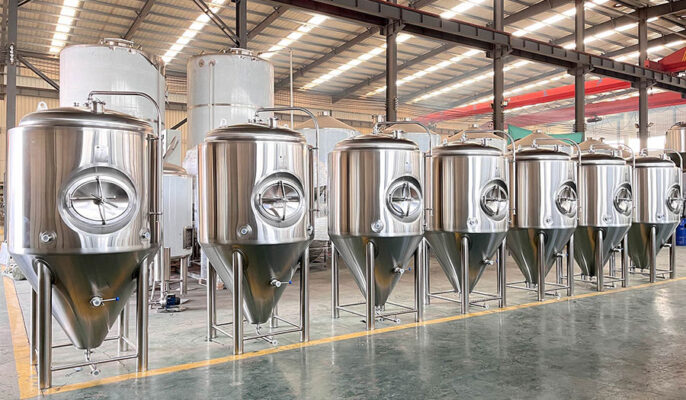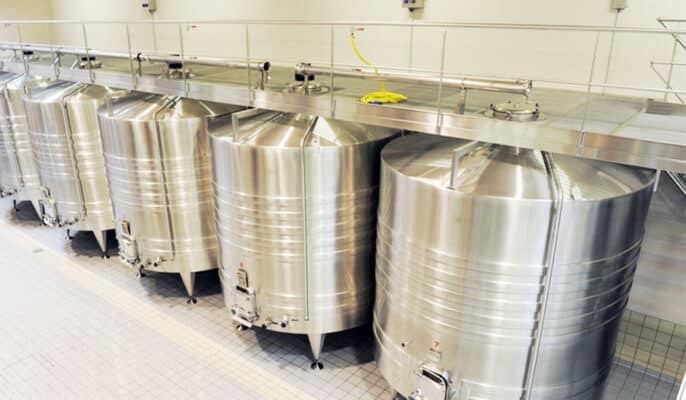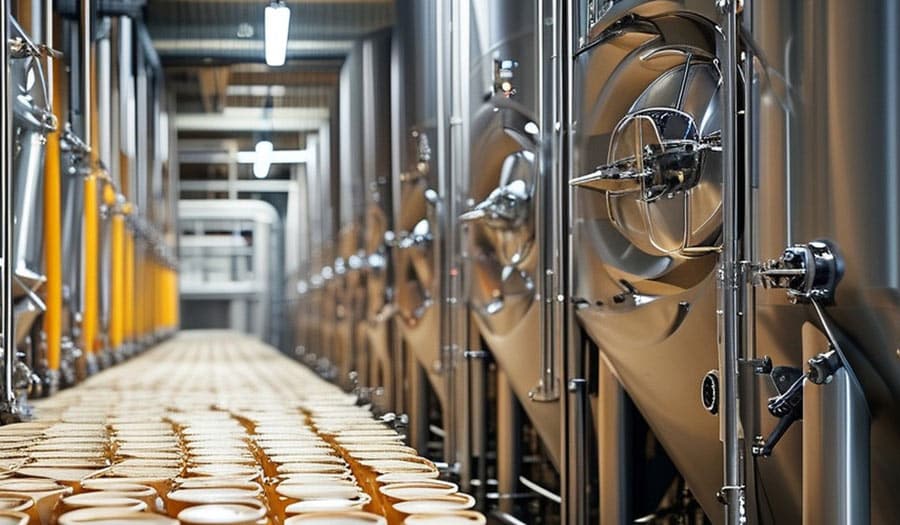Kuželové nádrže na kvašení piva z nerezové oceli představují jedno z klíčových zařízení v pivovarském vybavení, které kombinuje odolnost proti korozi s kuželovou konstrukcí a zajišťuje efektivní a hygienický proces kvašení. Těleso kvasné nádrže je obvykle vyrobeno z vysoce kvalitní nerezové oceli, která poskytuje vynikající odolnost a snadné čisticí vlastnosti a dokonale podporuje regulaci teploty a řízení kvasinek v procesu vaření piva. V tomto článku se můžete podrobně seznámit s procesem výroby piva v kvasných tancích tím, že pochopíte jejich strukturu a funkci.
Co je kužel z nerezové oceli fermentační nádrž?
Fermentační nádrže, známé také jako kvasné tanky nebo kvasné nádoby, jsou nádoby používané k uchovávání substrátů, jako je mladina nebo hroznová šťáva, pro kvašení. Tyto nádrže poskytují kvasinkám nebo jiným mikroorganismům potřebné prostředí pro přeměnu cukrů na alkohol a oxid uhličitý. Kuželové fermentační tanky z nerezové oceli jsou typem profesionálního zařízení používaného pro výrobu piva nebo jiných kvašených nápojů. Hlavním rysem nerezových kuželových kvasných nádrží je, že jsou vyrobeny z vysoce kvalitních nerezových materiálů a mají kuželovitý tvar. Zde jsou uvedeny jejich hlavní vlastnosti a funkce:
- Materiál: Materiál: Kuželové fermentační nádrže z nerezové oceli obvykle používají nerezovou ocel 304 nebo 316, která má vynikající odolnost proti korozi a trvanlivost a může zůstat hygienická a stabilní při dlouhodobém používání.
- Kuželovitá konstrukce: Kuželovitá konstrukce umožňuje, aby se usazeniny vzniklé během procesu kvašení (např. kvasinky, bílkoviny atd.) přirozeně koncentrovaly na dně nádrže. Pivovarníci tak mohou tyto usazeniny snadno odstranit, aniž by se přimíchaly do konečného produktu, což vede k čistšímu pivu.
- Systém řízení teploty: Mnoho kuželových fermentačních nádrží z nerezové oceli je vybaveno systémem regulace teploty, který zajišťuje, že fermentační proces probíhá v optimálním teplotním rozmezí. To je nezbytné pro zdraví kvasinek a kvalitu kvašení.
- Vypouštěcí ventil a otvor pro odběr vzorků: Tyto nádrže jsou obvykle vybaveny vypouštěcími ventily pro pravidelné vypouštění sedimentů a odběrovými otvory pro pivovary, které umožňují provádět kontroly kvality a odběr vzorků.
- Čištění a údržba: Díky nerezové oceli se tyto nádrže snadno čistí a udržují, což zabraňuje růstu mikroorganismů a zajišťuje hygienu fermentačního procesu.
- Těsnění: Kuželové fermentační nádrže mají obvykle dobré těsnění, které může účinně zabránit vnikání vzduchu a znečišťujících látek a zároveň regulovat uvolňování oxidu uhličitého a udržovat stabilní fermentační prostředí.

Typy kuželové fermentační nádrže z nerezové oceli
Konstrukce a funkce fermentační nádrže může výrazně ovlivnit účinnost fermentačního procesu a kvalitu produktu. Existují tři hlavní typy běžných fermentačních nádrží: otevřená, uzavřená a fermentační nádrž s proměnlivým objemem. Níže se budeme podrobně zabývat charakteristikami a scénáři použití jednotlivých typů.
Otevřená fermentační nádrž
Otevřená fermentační nádrž je jednoduchá nádoba bez víka nebo těsnicího zařízení. Tato konstrukce umožňuje, aby horní část nádrže byla neustále vystavena vzduchu, což je výhodné pro ruční obsluhu a přístup. Otevřené kvasné nádrže se nejčastěji používají ve vinařství, protože během kvašení hroznů je třeba slupky a semena hroznů plovoucí na povrchu tekutiny pravidelně stlačovat nebo míchat, aby bylo zajištěno rovnoměrné kvašení. Ačkoli tento typ nádrží poskytuje pohodlí při provozu, jejich vystavení vzduchu je náchylnější k vnějším kontaminantům.
Uzavřená fermentační nádrž
Uzavřená fermentační nádrž je opatřena těsnícím víkem, které má zabránit vniknutí jakýchkoli vnějších nečistot do nádrže. Tato uzavřená konstrukce je důležitá zejména pro vaření piva, protože dokáže účinně izolovat vzduch a zabránit oxidaci a kontaminaci, čímž se snižuje riziko kažení a vzniku zápachu. Uzavřené kvasné nádoby nejenže udržují stabilní kvasné prostředí, ale také lépe kontrolují uvolňování plynů a změny teploty během kvašení, což zajišťuje vyšší kvalitu kvašení piva.
Fermentační nádrž s proměnlivým objemem
Kvasné nádoby s proměnlivým objemem mají flexibilní konstrukci a jsou obvykle vybaveny plovoucím víkem a nastavitelným objemem. Tato konstrukce umožňuje uživatelům upravovat objem fermentoru podle potřeby, což je ideální pro domácí pivovarníky a malé pivovary. Flexibilita kvasných tanků s proměnlivým objemem umožňuje nejen přizpůsobení různým množstvím kvasné tekutiny, ale také minimalizuje kontakt kvasné tekutiny se vzduchem, čímž zlepšuje kvalitu a stabilitu kvašení. Díky univerzálnosti je tento tank oblíbený v malých pivovarnických provozech.
Úloha kuželových fermentačních tanků z nerezové oceli v procesu vaření piva
Kuželové fermentační nádrže z nerezové oceli hrají v procesu vaření piva zásadní roli a jejich konstrukce a funkce poskytují procesu kvašení mnoho výhod. Zde jsou uvedeny některé klíčové vlastnosti a jejich vliv na kvalitu kvašení:
- Kontrolované prostředí: Kuželové fermentační nádrže z nerezové oceli poskytují uzavřené a kontrolované fermentační prostředí, které dokáže účinně izolovat vnější kontaminanty, jako jsou divoké kvasinky, bakterie a drobné částice ve vzduchu. Tato uzavřená konstrukce nejen chrání čistotu fermentovaného produktu, ale také zajišťuje stabilitu fermentačního procesu, což pomáhá udržet vysokou kvalitu produktu.
- Regulace teploty: Mnoho fermentorů, zejména uzavřených fermentačních nádrží, je vybaveno pokročilými systémy regulace teploty. Teplota je v procesu kvašení klíčovým faktorem, protože přímo ovlivňuje metabolismus a dynamiku kvašení kvasinek. Přesnou regulací teploty může fermentor zajistit, aby kvasinky pracovaly v nejlepších podmínkách, a tím optimalizovat chuťové vlastnosti a celkovou kvalitu konečného výrobku.
- Míchání a míchání: Některé fermentační nádrže z nerezové oceli jsou vybaveny vestavěnými míchadly pro účinné míchání kapaliny. Správné míchání pomáhá nejen při rovnoměrném kvašení, ale také zlepšuje účinek regulace teploty a podporuje zdraví kvasinek. To je důležité zejména u velkokapacitních fermentorů, protože rovnoměrné míchání může snížit lokální teplotní rozdíly a nerovnoměrné rozložení kvasinek.
- Separace sedimentu: Kuželové fermentační nádrže jsou navrženy speciálně pro zpracování sedimentů vznikajících během fermentace. Kuželovité dno umožňuje přirozené usazování kvasinek a dalších usazenin na dně, což zjednodušuje následný proces jejich odstraňování. Tato konstrukce nejen usnadňuje odstraňování sedimentu, ale také zvyšuje účinnost filtrace a zpracování konečného produktu.
- Karbonizace: Některé fermentační nádrže, zejména jednotkové nádrže, mají také funkci sycení. Po ukončení kvašení lze tyto nádrže saturovat ve stejné nádobě, aniž by bylo nutné tekutinu přelévat do jiné nádoby. Tato integrovaná funkce nejenže šetří čas a práci, ale také snižuje riziko kontaminace, které by mohlo vzniknout během procesu přelévání.
Kolik fermentační nádrže potřebuji pro svůj proces vaření?
Velikost dávky
Kapacita vaší dávky je základním faktorem pro určení počtu potřebných kvasných nádrží. Čím větší šarže, tím více fermentačních nádrží budete obecně potřebovat, ale tento vztah není vždy lineární a je třeba vzít v úvahu faktory, jako je doba fermentace, prostoje při čištění a údržbě zařízení a požadovaná kapacita. Pokud je například cílem udržet stálou týdenní produkci, budete potřebovat dostatek fermentačních nádrží, abyste mohli efektivně rozložit výrobní cykly.
Výrobní kapacita
Určete, kolik piva plánujete v daném časovém horizontu vyrobit. Může to být týdně, měsíčně nebo ročně. Vypočítejte celkový objem piva, který chcete vyrobit, a vydělte jej velikostí várky, abyste získali představu o tom, kolik várkách budete potřebovat vykvasit. Určení průměrného kvasného cyklu pro každý typ piva je jedním z klíčových faktorů pro výpočet výrobní kapacity.
Počet potřebných fermentorů vypočtete tak, že očekávanou produkci vydělíte velikostí dávky. Tím získáte minimální počet nádrží potřebných k dosažení cílové měsíční produkce.
Pokud je například očekávaná produkce 4 000 litrů za měsíc a velikost šarže 1 000 litrů, je počet potřebných fermentačních nádrží nejméně 4. Je však důležité vzít v úvahu praktické faktory, jako je údržba, čištění a překrývání šarží. Přídavné fermentační nádrže mohou pomoci tyto faktory zohlednit a zajistit hladší provoz. Doporučuje se přidat rezervu zvýšením počtu fermentorů na počet mírně převyšující minimální požadavek.
Typ kvašení a specifické požadavky
Každý proces fermentace má jedinečné požadavky. Vaření piva, kvašení vína, výroba octa nebo kvašených mléčných výrobků vyžadují specifické podmínky, jako je kontrola teploty, vystavení kyslíku nebo doba zrání. Pochopení složitosti zvoleného typu fermentace vám pomůže zvolit vhodný počet a typ fermentačních nádrží.
Odhad doby kvašení
Pokud plánujete provádět více fermentací současně, ovlivní to počet potřebných fermentačních nádrží. Současná správa různých produktů nebo šarží vyžaduje další fermentory a pečlivé plánování, aby se zabránilo křížové kontaminaci nebo rušení mezi fermentacemi. Možnost rozložit fermentace a optimalizovat využití fermentoru může pomoci udržet konzistentní výrobní plán.
Pokud kvašení jedné dávky produktu trvá 10 dní a vaším cílem je připravit každých 10 dní novou dávku, potřebujete dostatek fermentorů, abyste tento cyklus udrželi. To může znamenat 10 fermentorů, aby každá šarže mohla kvasit samostatně a nemusela čekat na dokončení předchozí šarže.
Flexibilita a všestrannost
Zvažte kombinaci fermentačních nádrží různých velikostí, abyste zvýšili provozní flexibilitu. Menší kvasné nádoby jsou univerzální pro experimentální šarže, limitované edice nebo specifické produkty. Na druhou stranu větší fermentační nádrže mohou pojmout standardní výrobní série a pomáhají zlepšit celkovou efektivitu. Tato kombinace umožňuje přizpůsobit se požadavkům trhu a zkoušet nové receptury.
Zvažte překrývající se cykly
Efektivní využití fermentorů zahrnuje překrývání fermentačních cyklů. Zatímco jedna várka kvasí, jiná várka může začínat nebo končit. Tím se minimalizují prostoje a maximalizuje výtěžnost. V závislosti na době fermentace můžete potřebovat méně fermentačních nádrží, než je počet vyráběných šarží, pokud se cykly efektivně překrývají.
Infrastruktura a prostorová omezení
Omezení dostupného prostoru a infrastruktury mohou omezit počet nádrží, které jsou v určité oblasti k dispozici. Rozhodující je vyvážení provozní účinnosti a dostupného prostoru. Efektivní využití stávající infrastruktury může vyžadovat investici do větších fermentorů nebo optimalizaci uspořádání pro lepší pracovní postupy. Zajistěte, aby zařízení splňovalo bezpečnostní a hygienické normy, a zároveň zvažte možnost budoucího rozšíření.
Rozpočet a přidělování zdrojů
Počet fermentorů, které si můžete zpočátku pořídit, může být ovlivněn rozpočtovými omezeními. Může být vhodné začít s malým počtem univerzálních fermentačních nádrží a pak je postupně rozšiřovat podle potřeb výroby a finančních možností. Při výpočtu počtu fermentorů upravte svůj plán na základě rozpočtových omezení. Vyvážení ideálního počtu fermentorů a finančních hledisek může vyžadovat investování po etapách a stanovení priorit na základě aktuálních potřeb. Pečlivým vyhodnocením dynamiky šarží, doby fermentace, rozsahu výroby, typu fermentace a potřeb flexibility můžete přizpůsobit infrastrukturu fermentačních nádrží tak, abyste optimalizovali efektivitu a splnili specifické požadavky vaší fermentační práce. Samozřejmě se můžete obrátit i na skupinu Micet a technici vám vyvinou řešení, které vám bude vyhovovat.

Jak vybrat správnou kuželovou fermentační nádrž z nerezové oceli?
- Kapacita: Určete svou varnou stupnici, abyste zvolili správnou kapacitu nádrže. Pro domácí vaření piva nebo malé pivovary mohou být vhodnější menší kvasné tanky, zatímco velkovýroba vyžaduje tanky s větší kapacitou. Ujistěte se, že kapacita tanku odpovídá vašim výrobním potřebám, abyste zvýšili efektivitu a flexibilitu.
- Systém řízení teploty: Pokud potřebujete přesně kontrolovat teplotu kvašení, je nezbytné zvolit fermentační nádrž vybavenou pokročilým systémem regulace teploty. Ujistěte se, že systém regulace teploty dokáže zajistit stabilní regulaci teploty, aby podpořil přesné řízení procesu kvašení a optimalizoval aktivitu kvasinek a chuť konečného výrobku.
- Materiál: Důležitým kritériem při výběru fermentační nádrže je vysoce kvalitní nerezová ocel (např. 304 nebo 316). Tyto materiály mají nejen vynikající odolnost proti korozi a trvanlivost, ale také zjednodušují proces čištění a údržby a udržují nádrž hygienickou a dlouhodobě použitelnou.
- Konstrukční prvky: Věnujte pozornost konstrukčním detailům fermentační nádrže, včetně úhlu kónického dna, umístění a velikosti vypouštěcího ventilu atd. Tyto konstrukční prvky přímo ovlivňují hospodaření se sedimentem a účinnost čištění nádrže. Výběr správné konstrukce může zvýšit pohodlí a účinnost fermentačního procesu.
- Možnost míchání a míchání: U fermentačních procesů, které vyžadují rovnoměrné míchání, pomůže výběr fermentační nádrže s vestavěným míchadlem zajistit rovnoměrnost fermentační kapaliny. To nejen podporuje zdraví kvasinek, ale také zlepšuje konzistenci a účinnost fermentačního procesu, což je důležité zejména při velkoobjemovém kvašení.
- Řízení plynu: Ujistěte se, že je fermentor vybaven účinným systémem odvodu plynů, který správně zpracovává oxid uhličitý vznikající během procesu kvašení. Tím se zabrání nadměrnému tlaku a udrží se stabilita nádrže, aby se předešlo případnému přetečení nebo jiným problémům.
- Rozpočet: Vyberte si správnou fermentační nádrž podle svého rozpočtu. Ceny fermentorů různých značek a funkcí se značně liší. Zvažte výkon a cenu a vyberte si cenově nejvýhodnější zařízení, které splní vaše potřeby a zároveň bude kontrolovat náklady.
- Dodavatelé a služby: Výběr renomovaného dodavatele je důležitým krokem k zajištění kvality zařízení a následných služeb. Seznamte se s recenzemi zákazníků a servisními záznamy dodavatele, abyste měli jistotu, že po nákupu získáte kvalitní poprodejní podporu a řešení problémů.
ČASTO KLADENÉ DOTAZY
Co je to kuželová fermentační nádrž z nerezové oceli?
Kuželová fermentační nádrž z nerezové oceli je fermentační zařízení vyrobené z vysoce kvalitní nerezové oceli s kuželovým dnem, speciálně navržené pro výrobu piva nebo jiných kvašených nápojů.
Proč zvolit nerezovou ocel?
Nerezová ocel má vynikající odolnost proti korozi, trvanlivost a snadné čištění. Může zabránit kontaminaci, zajistit hygienu fermentačního procesu a prodloužit životnost nádrže.
Jak vybrat správnou kapacitu fermentační nádrže?
Kapacita by měla být určena podle rozsahu vaření. Domácí vaření nebo malá výroba obvykle vyžaduje nádrž s menší kapacitou, zatímco velkovýroba vyžaduje nádrž s větší kapacitou. Ujistěte se, že kapacita odpovídá vašim výrobním potřebám, abyste zvýšili efektivitu a flexibilitu.
Jaké jsou výhody kuželové konstrukce?
Kuželovitá konstrukce dna umožňuje, aby se usazeniny vzniklé během procesu kvašení přirozeně usazovaly na dně nádrže a snadno se odstraňovaly. Tato konstrukce pomáhá udržovat čistotu fermentační tekutiny a zjednodušuje proces čištění a filtrace.




